Canfield Jedi 29
Wheel Size: 29’’
Travel: 203mm rear / 200 mm front (see below)
Material: Aluminum
Price:
- Frame only: $2,600
- Complete bikes from $6,300
- Frame + shock and frame + shock + fork packages available, see below for details
Reviewer: 6′, 170 lb / 183 cm, 77.1 kg
Size Tested: Large
Blister’s Measured Weight: 41.0 lb / 18.6 kg
Test Locations: Washington, British Columbia
Test Duration: 3.5 months
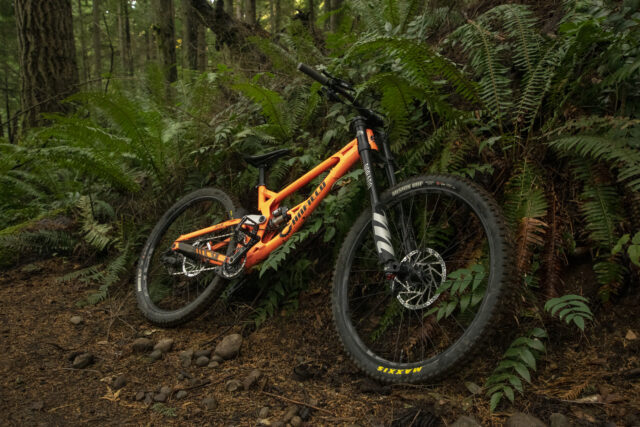
Intro
We’ve talked a lot about how high-pivot bikes are having a resurgence of late but they’re certainly not a new idea, and perhaps the most famous bike from their original heyday in the 2000s was the Canfield Jedi. Well, after a few years’ hiatus, the Jedi is back, and it’s still got the familiar dual-link, high-virtual-pivot layout of its predecessors. There’s a whole lot that is new though, including 29’’ wheels, modernized geometry, and substantially redesigned suspension kinematics, so let’s dive in.
The Frame
Carbon DH bikes may be commonplace these days, but Canfield is sticking to aluminum with the Jedi. Not that we’re complaining. Saving weight on a DH frame isn’t a super high priority, and we’ve even seen brands like Trek — who offered one of the first carbon DH bikes on the market — go back to aluminum-only with their latest Session.
As folks who are familiar with the earlier iterations of the Jedi would expect, the new Jedi 29 uses a dual mini-link suspension layout, with a significantly rearward axle path and an idler pulley to keep chain growth in check — Canfield claims less than 1mm total growth through the entire travel. Pedal kickback numbers aren’t published, but given the near-zero chain growth, there should be almost none.
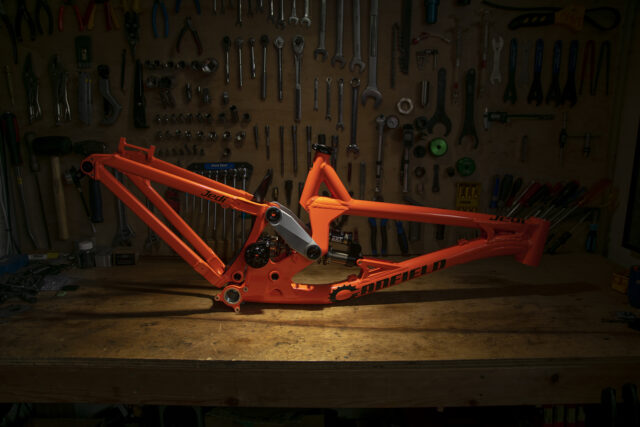
Interestingly, Canfield isn’t referring to the suspension layout by their CBF (Canfield Balance Formula) trademark, and instead is bringing back the “Formula 1” name that they used on prior iterations of the Jedi. And that does make some sense — though both the CBF layout (as used on a number of bikes from both Canfield and Revel, including the Lithium, Rail, and Ranger) and the Formula 1 designs are dual mini-link layouts, they are substantially different in terms of link placement and configuration, in addition to the Formula 1’s idler pulley.
That’s not to say that Canfield hasn’t revised the kinematics from the prior-generation Jedi, though. Perhaps most notably, Canfield is quick to point out that “a revised axle path allows it to corner and jump more intuitively than previous versions.” Having ridden a few earlier Jedis, that line, in particular, is quite exciting — the Jedis of old had extremely rearward axle paths, which felt great when trying to carry speed through rough sections of trail but could also feel awkward when trying to preload the suspension off lips, or when loading it up into corners. Canfield says that the new Jedi 29 has 19 mm of rearward travel (compared to 33 mm on the 2015-2017 bike) and I’m very curious to see how the new bike compares in terms of on-trail feel.
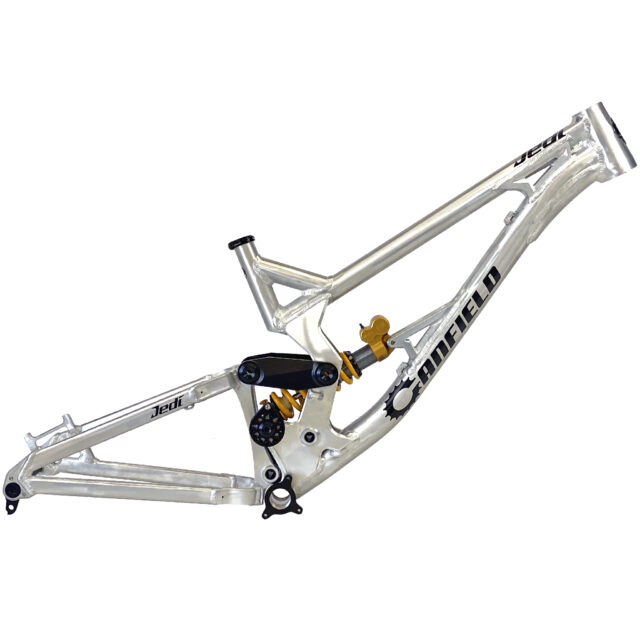


Canfield also says that the suspension kinematics have been tweaked to increase progression in the leverage curve, bolster midstroke support, and achieve slightly less anti-rise, for more neutral braking performance than the old bike.
Elsewhere, the features of the Jedi 29 frame are pretty standard for a modern DH bike. You get an 83mm threaded bottom bracket shell, 157 x12mm dropouts, ISCG-05 tabs (complete bikes come with a custom MRP chainguide, designed for the high-pivot and idler arrangement) and a ZS44/56 mm headtube. The Jedi 29 takes a 250 x 75 mm shock with 20 x 8 mm hardware at both ends if you want to BYO — a bare frame, frame + shock, and frame + shock + fork packages are all available, in addition to a complete bike, as we’ll describe in more detail below.
Fit & Geometry
The Jedi 29 is offered in three sizes, Medium through Extra Large. The headtube angle on all three is 62.5° degrees, and they all share the same 427 mm chainstay length. That’s very short for a modern DH bike, though Canfield notes that they measure 443 mm at sag, due to the substantially rearward axle path. That’s still perhaps a touch on the short-ish side, but not by nearly as big a margin.
Reach ranges from 450 to 500 mm in neat 25 mm increments, all of which add up to wheelbases starting at 1,252 mm on the Medium, up to 1,304 mm on the XL. Canfield says that range covers riders from 5’5’’ to 6’6’’ (165 to 198 cm)
The Build
Canfield only offers one official build for the Jedi, but it’s quite customizable, with options for the suspension, brakes, wheels, and drivetrain. Our review bike featured the TRP DH-7 drivetrain, which is no longer on offer, paired with a Manitou Dorado Expert fork, TRP DH-R Evo brakes, an EXT Arma MX shock, and e*Thirteen LG-1 DH wheels. The base specification is shown below; check Canfield’s website for all the options.
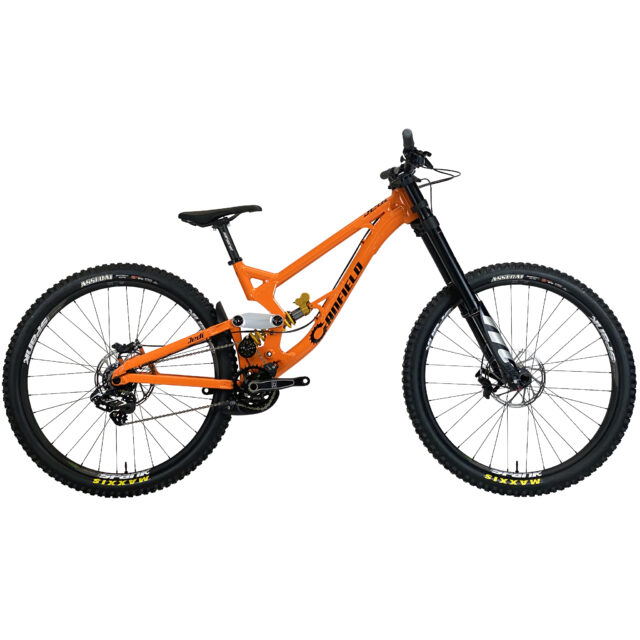
- Frame and shock or frame, shock, and fork packages available; see Canfield’s website for details.
- Fork: DVO Onyx DC D1
- Shock: DVO Jade
- Drivetrain: Shimano Saint
- Crankset: Canfield
- Brakes: TRP DH-R Evo
- Wheels: e*thirteen LG1 Plus
Some Questions / Things We’re Curious About
(1) The revised suspension kinematics of the new Jedi 29 sound like they should keep a lot of the ability of the old bike to carry speed in rough terrain, with far fewer downsides — but is that really the case on trail?
(2) And how does the Jedi 29 stack up against other high-pivot DH bikes, such as the Trek Session and Commencal Supreme?
Bottom Line (For Now)
It’s always exciting to see bikes with as storied histories as the Canfield Jedi resurface, and the new Jedi 29 looks to be a very promising take on a modern DH race bike. We’re hoping to be able to get on one for a full review when they’re available next year and look forward to finding out how the Jedi 29 stacks up against both its predecessors and the current DH bike market.
FULL REVIEW
The Canfield Jedi has been one of the longest-standing high-pivot DH bikes on the market, spanning the era between high pivots’ initial heyday and their more recent resurgence. After a couple of years’ hiatus, the Jedi is back, this time with 29’’ wheels, revised geometry, and a refined version of Canfield’s Formula 1 high virtual pivot suspension layout. Having now spent much of the summer on the new Jedi 29, I think it’s an excellent take on what a modern DH race bike can be.
I also haven’t been on a bike in recent memory that attracted as much attention in the lift line — from seasoned riders familiar with Canfield’s history to young groms who hadn’t even heard of the brand, everyone seemed intrigued, including me.
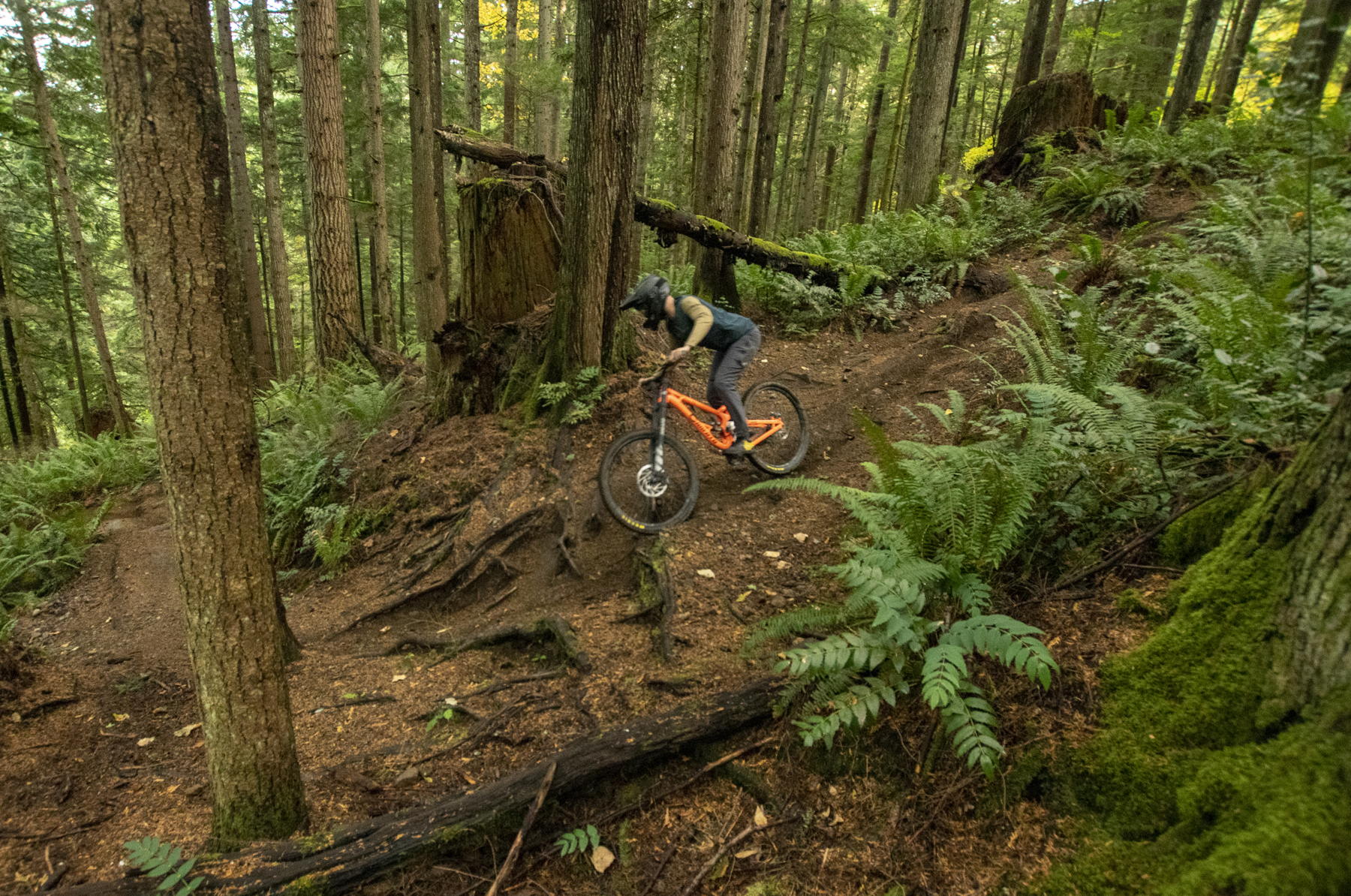
Fit and Geometry
I’ve been testing a Large Jedi 29, and at 6’ (183 cm) tall, I’m squarely in the middle of Canfield’s recommended range for that size — but also just an inch off the ranges for the Medium and XL. There’s a lot of overlap on their suggested sizing, noting (rightly, I think) that bike fit is rarely as simple as matching height to frame size, with a lot of wiggle room based on personal preferences, riding style, body proportions, and so on.
And for the most part, I’ve been happy with the Large. If anything, I’d be curious to try an XL — and definitely am not interested in the Medium — but I tend to prefer somewhat longer bikes in general, and think that the Large probably is the right size for me in most situations.
At 475 mm the reach on the Large Jedi 29 is perhaps a touch on the shorter side for my typical preferences, but once I added about 12 mm of stem spacers (having already set the upper crown as high as I could) and trimmed the bars to 790 mm (from 810 mm) I was feeling quite comfortable on the Large frame. The overall fit feels slightly on the compact side for my typical preferences, but that works well with the handling of the Jedi 29 (more on that in a minute) and I’ve rarely found myself wanting a substantially longer bike. I think my personal ideal sizing would probably be somewhere between the Large and XL, but given the existing options, I do think that the Large was the way to go (and I’m definitely splitting hairs a bit with that semi-XL proposal).
Build and Spec
Canfield has changed their build options a bit since we got our Jedi 29 in for testing (we’re not totally out of the woods yet on Covid-related supply chain issues), but most of the key stuff from the build that we’ve been testing is still available as an option.
Our review bike showed up outfitted with a Manitou Dorado Expert fork and EXT Arma MX shock, plus TRP DH-R Evo brakes, a TRP DH7 drivetrain, and e*Thirteen LG1 Plus wheels. The TRP drivetrain option has been dropped (with a Shimano Saint one in its place) but the rest of those parts are still on offer. The Dorado Expert ($100) and Arma ($300) come with a bit of an upcharge over the base DVO suspension, bringing the closest current equivalent build to $6,800 all-in.
All told, it’s a nice build with good parts where they’re most needed (suspension and brakes) and solid but not super expensive options elsewhere (cockpit, wheels). As I’ve found with a lot of TRP’s brakes over the years, the DH-R Evos have a slightly longer reach range than I’d prefer, but I do tend to run my brakes quite close to the bar, and in other respects, they’ve been great. We’ll have a full review of those up soon, so stay tuned for that.
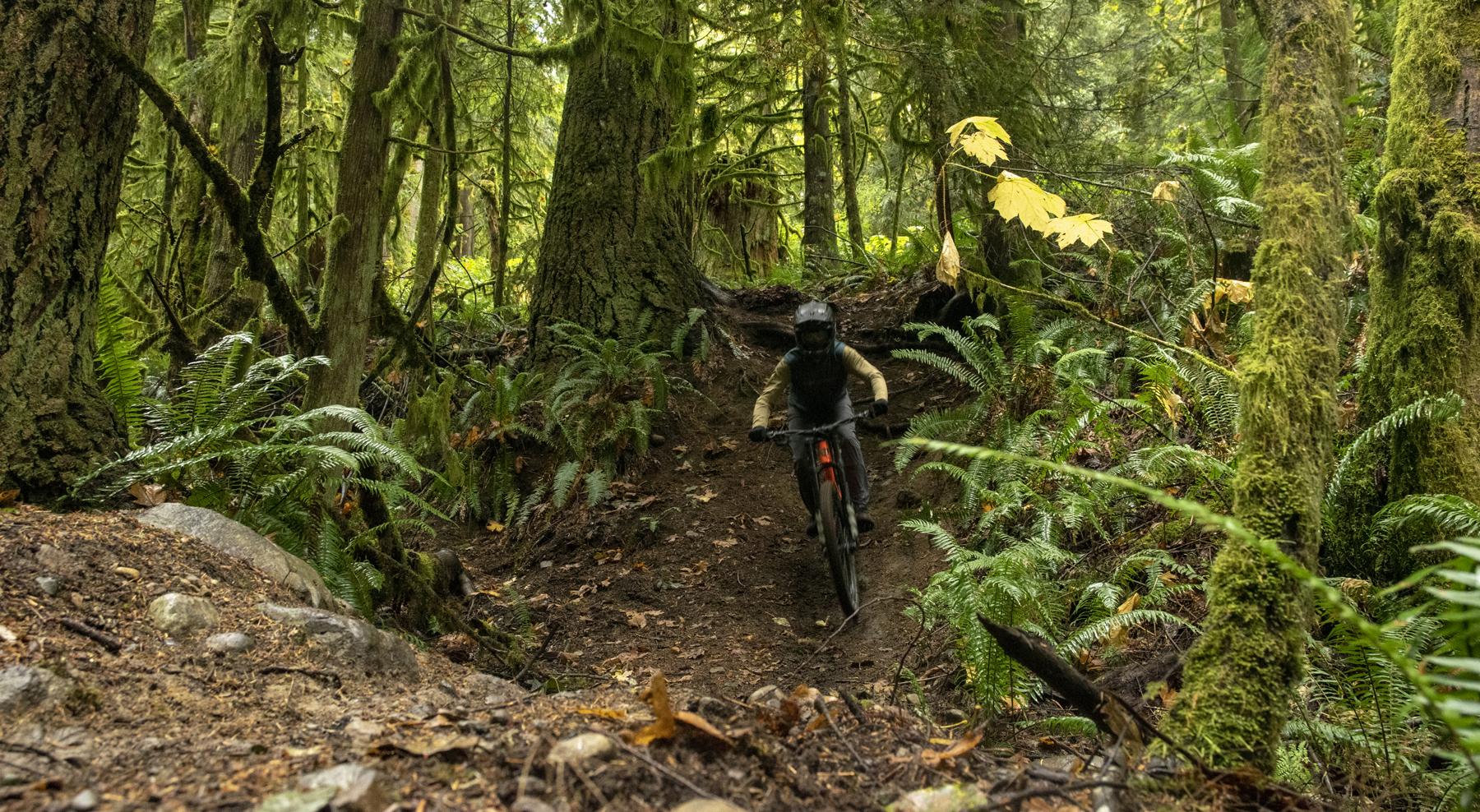
The biggest standout from the parts spec is probably the EXT Arma rear shock, which, in conjunction with the well-sorted kinematics of the Jedi 29 frame, produced what is (at least in some respects) the best performing rear suspension of any bike I’ve been on recently. Canfield sent the shock with both 375 and 400 lb springs for my 170 lb / 77.1 kg weight; I ended up clearly preferring the extra support offered by the 400 lb option, which felt right on the money for me.
The Manitou Dorado Expert fork mostly did a good job of keeping up with the outstanding rear suspension. The small-bump sensitivity from the front end wasn’t quite as good as what the rear could offer, but it didn’t feel wildly mismatched, and while the modest torsional stiffness of the inverted Dorado chassis was noticeable, I found it to be far less of a problem than I’d perhaps anticipated — especially given that I have found the modern crop of extra-burly single crowns (RockShox ZEB et. al.) to be an extremely worthwhile change to the mountain bike fork landscape. I’d mostly write that up to the fore-aft stiffness of the Dorado being quite good, and the fact that it doesn’t bind or otherwise stop sliding badly when it’s deflecting a bit. While the tracking of the front wheel does feel somewhat less precise than it does with a torsionally stiffer fork, I found it quite easy to adapt to the feel of the Dorado chassis. Blister Members can read my Flash Review of the Dorado that goes into more detail on that, and we’ll have a full review up soon.
I was also able to test the higher-end Dorado Pro on the Jedi 29, and did find it to be a worthwhile upgrade over the Expert version, mostly because its significantly better midstroke support enabled me to strike a setup balance that improved small-bump sensitivity somewhat (because I wasn’t needing to compromise as much to get the support that I wanted, especially on very steep trails). That difference is mostly down to the dual-positive chamber IRT air spring in the Pro, which can be retrofitted to the Expert for about $100.
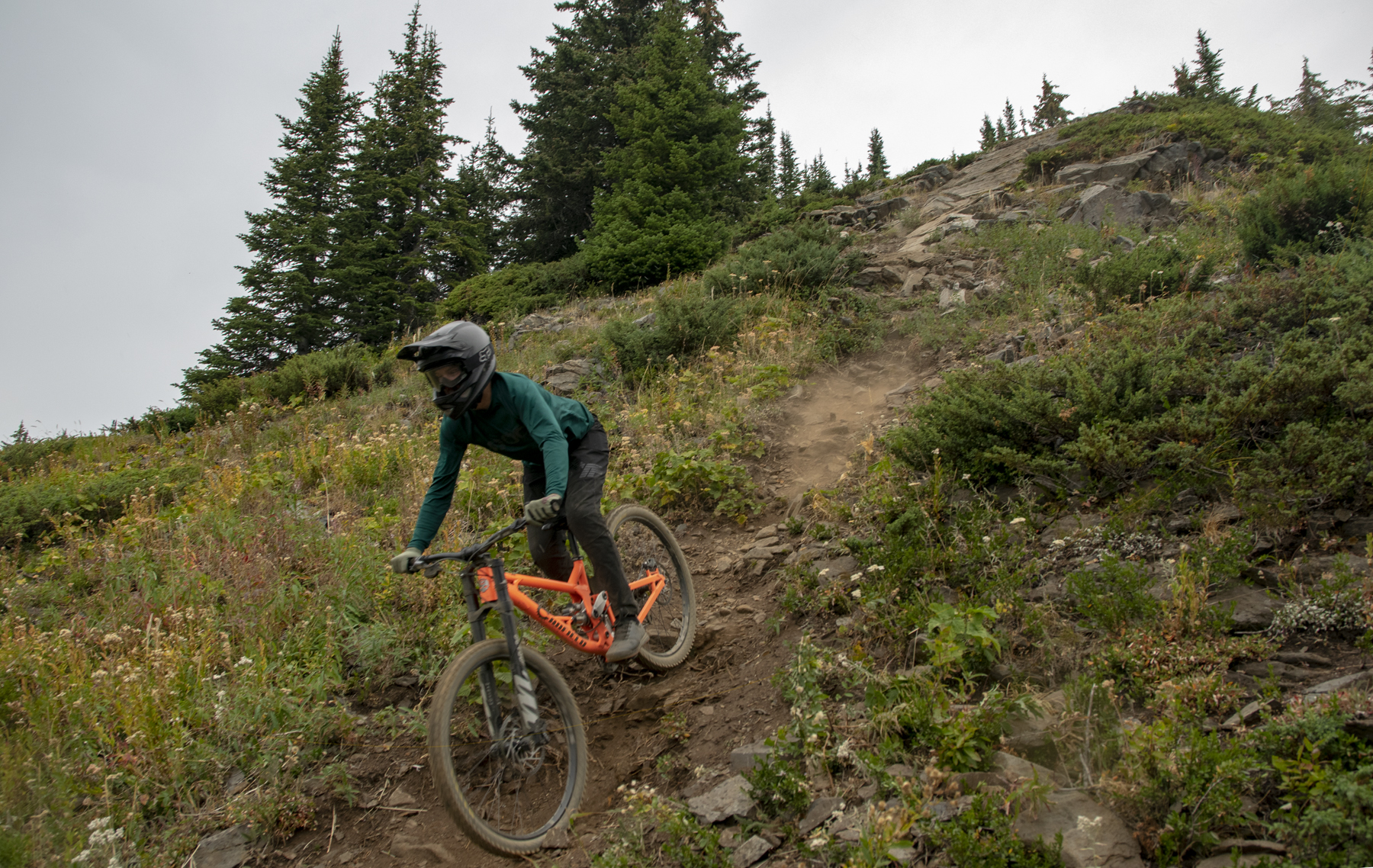
I didn’t have any problems with the e*Thirteen LG1 Plus wheels, but their proprietary cassette is the sort of thing that makes me nervous when it comes to long-term ownership. The idea behind it is sound in some respects — it’s a 7 speed cassette that spaces the hub flanges wider for better spoke bracing angles, and integrates the freehub into the cassette itself to compactly package a 9 tooth small cog — but just know that you’re stuck with their replacements if you go that route. More conventional wheels with Spank 359 rims and Hadley hubs (my personal favorites on the market) are available as an upgrade.
Suspension Performance and Handling
Canfield was one of the earliest proponents of high-pivot suspension layouts, dating back to the original Big Fat Fatty Fat from the late 1990s, and the Jedi 29 is the latest iteration of their high (virtual) pivot DH-bike lineage. While past iterations of the Jedi have consistently been great at plowing through rough terrain with abandon, they’ve also sometimes displayed somewhat quirky behavior when jumping and cornering, since the rear end grows dramatically longer as you get deeper into the travel.
But with the new Jedi, Canfield has done a really good job of ironing out those quirks while maintaining what the earlier iterations did well — and the resulting suspension performance is seriously impressive. The EXT Arma rear shock (which I mostly ran with a 400 lb spring) deserves its fair share of the credit, but I think the refined kinematics of the new bike go a long way, too. For one thing, the axle path is just a bit less rearward than it was on the prior iteration of the bike, meaning that the rear end doesn’t grow quite as dramatically. And because the suspension feels supportive and predictable, I didn’t have the same sorts of issues with the balance point abruptly shifting rearward on the bike as the suspension compressed, as I have on some other high-pivot bikes (most notably the Forbidden Dreadnought).
So I generally got along well with the cornering behavior of the Jedi 29. It’s biased a bit toward just running over whatever’s in its path rather than feeling ultra-precise and easy to place exactly where you want (I think the not-super-stiff-torsionally Dorado Expert fork is a significant piece of that). But its cornering behavior — both in tighter spots and in bigger, faster corners — is predictable and intuitive, without displaying much of the quirky weight shifts and inconsistencies that I’ve felt on some other high-pivot bikes, including earlier iterations of the Jedi. Canfield has done a really good job of smoothing out the rougher edges of prior iterations while preserving a lot of what made them great.

One of the most impressive things about the Jedi 29 is how well it manages to be relatively nimble (by DH-bike standards) without feeling like it gives up a ton of straight-line stability to get there, and I think the Jedi 29’s suspension deserves a lot of the credit for that, too. Probably the most standout number on the Jedi 29’s geometry chart is the 427 mm chainstay length, which is extremely short for a modern DH bike — but due to the very rearward axle path, that number grows to ~443 mm at sag, and keeps getting longer deeper in the travel.
Especially when trying to snake the Jedi 29 through tight spots, where I was more upright and not loading up the suspension too much, it felt notably more compact and easy to throw around than some other DH bikes I’ve been on recently (particularly the size R3 Trek Session that I reviewed last year). When you compare the respective wheelbases of those two bikes, that’s not a huge surprise. The sizing isn’t 100% apples-to-apples, to be sure, and the Jedi’s axle path is more rearward so the sagged numbers are going to be a bit closer, but the Session’s static wheelbase is more than 40 mm longer — which is to say, a ton.
But when things open up and start getting faster, the Jedi 29 feels quite stable and composed, especially when you consider that it’s not a crazy long bike on paper. In many dynamic situations, the Jedi 29’s wheelbase isn’t as short as its static numbers might make it sound, due to the very rearward axle path, but the suspension also does such a good job of ironing out high-speed chatter that I didn’t feel like I needed a huge amount of room to move around on the Jedi 29 to keep things in check when I was plowing into high-speed rough sections. The suspension just felt smooth, planted, and composed — in a word, excellent.
Put differently, the Jedi 29 doesn’t feel like a bike that needs to be sized up on and run super long in order to be pretty stable at speed. And the other things that are going on with its geometry and suspension feel like they’re also well suited to running a not-crazy-big fit on the bike.
Specifically, bikes that both fit a bit smaller and require aggressive weighting of the front wheel to maintain proper weight distribution can feel like they’ve got a relatively small sweet spot in terms of body positioning; e.g., if you’re far enough forward to weight the front wheel effectively, you’re also in a more compact body position from which you’re prone to getting thrown forward when the bike hangs up on an impact. But between the Jedi’s suspension doing a great job of keeping the bike from getting hung up in the first place, and the more neutral, upright body position that the bike encourages, I didn’t find that to be an issue at all. The Large Jedi 29 sometimes felt a little small when I first hopped on it, coming off a number of the roomier-fitting other bikes I’ve been spending time on, but that sensation quickly disappeared once I started riding it.
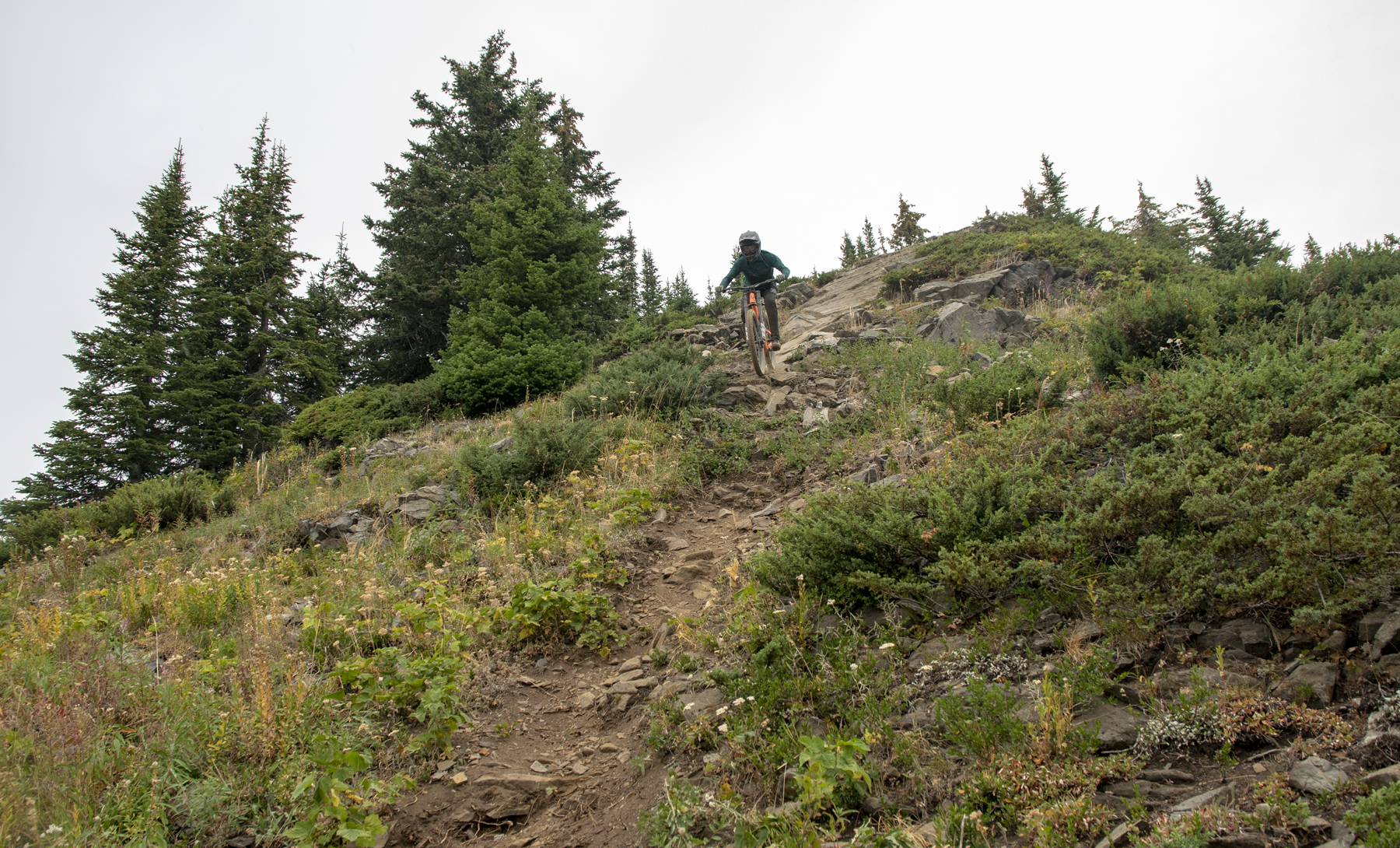
The tradeoff that comes with the Jedi 29’s ultra-planted suspension is that it’s not a very lively-feeling bike, and definitely takes more work to pump through rollers and boost off jumps than a lot of other DH bikes. But, somewhat to my surprise, the Jedi 29 didn’t really display any quirky or troublesome behavior there, either — it just feels a little bit muted, and doesn’t return a ton of energy when you load up the suspension. Again, I think that’s a very fair tradeoff for the Jedi 29’s suspension performance in rough terrain, and all of the most stable, planted-feeling bikes I’ve been on (across a range of classes) exhibit a similar tradeoff.
The Trek Session is an interesting comparison, as another high-pivot DH bike, but one that goes about things pretty differently from the Jedi 29. The Session’s axle path is far less rearward overall than the Jedi 29’s, and while the Session does a very good job of feeling composed and stable through rough high-speed sections, the quite-big size R3 bike I rode (a size I was very happy with) felt like it was relying on its length / wheelbase for stability a bit more, whereas the Jedi 29’s suspension is a bit more composed and planted, and manages to produce similar overall stability from a more compact package. The Jedi 29 has a clear advantage in terms of small-bump sensitivity and plushness, while still feeling nicely supportive and not the least bit wallow-y, but the Session is a bit more lively and easier to pump and boost through / off things, though that’s not really the strong suit of either bike.
Who’s It For?
Canfield describes the Jedi 29 as a “podium-seeking missile” and they’re right to talk about it as a very capable DH race bike. But what’s impressed me the most about the Jedi 29 is that it manages to be that without feeling super high-strung and unforgiving when you want to take things easier. And so I can also easily see it being a good everyday park bike for folks who tend to prefer more natural tech trails and raw terrain over a ton of flow trails and jumps.
That’s not to say that the Jedi 29 jumps poorly, but it’s far more planted and composed than it is lively or poppy, and isn’t very energetic when you’re really trying to boost off a lip, especially as the jumps get steeper. That seems like a fair tradeoff for the Jedi 29’s truly excellent suspension performance in fast, rough terrain — and Canfield has the One.2 in their lineup for folks who want a more playful DH/Freeride bike — but it’s just another instance where it’s best to know thyself and think through your priorities. If a very planted, composed bike with outstanding suspension performance sounds like the right fit, the Jedi 29 is excellent.

Bottom Line
Canfield describes the Jedi 29 as a DH race bike first and foremost, and it certainly feels like it could be a good one for the right riders. Its suspension is outstanding, particularly when it comes to carrying speed in rough terrain, and the Jedi 29 manages to be just a little more nimble and easy to throw around than a lot of similarly-stable bikes (or vice versa). But because it doesn’t need to be sized up on or run with super stiff suspension settings to be composed and stable at speed, it’s also pretty easy to imagine the Jedi 29 really clicking for folks who don’t spend much time between the tape, but just want an everyday DH / park bike for riding fast, rough, technical trails.
The tradeoff to all that is that the Jedi 29 isn’t terribly lively or poppy, and is merely a competent, but not particularly inspiring bike in the air. But that’s not what Canfield designed it to excel at, and if you care more about suspension performance on raw, rough, trails, there’s a lot to like here.

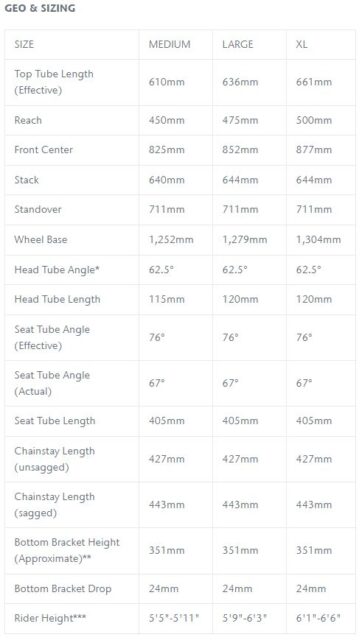
David, you mention in the review that Hadley hubs are your personal favorite. I can’t find much info on them, so I don’t see what makes them stand out – what makes them special to you?
They’re remarkably durable without being crazy heavy, the secondary sealing is excellent so the bearings last forever, they’re easy to work on with relatively standard tools (just cone wrenches and a pin spanner) and unlike most modern hubs the bearing preload is adjustable so you can dial that in and get them to spin really well. The freehub is also super quiet.
I got a crazy good deal on a built Canfield Balance. Fox Fac. 38, Ext Storia, XTR brakes, plus oil slick components to compliment the raw finish. It rides even better than it looks. Maybe/probably it’s the coil, but I really like how it rides. Very different (of course) than my YK Capra pro race which has a 36 Fox Fac. but the FOX X2 FLOAT Factory. From what I’ve read I think I would like a coil on the Capra…
Assumingly the EXT shock on this particular bike was ARMA v3? Not ARMA MX since it’s a dedicated shock for Sur Ron e-bikes.
Nope, EXT did a run of the Arma MX specifically for the Jedi. This was one of those.
https://extusa.bike/products/arma-mx-jedi-edition
That’s interesting to hear! Thanks for the prompt reply.